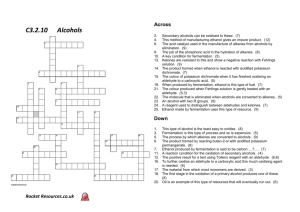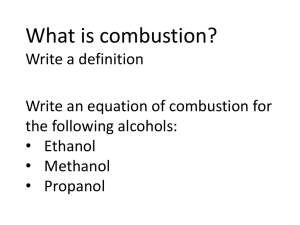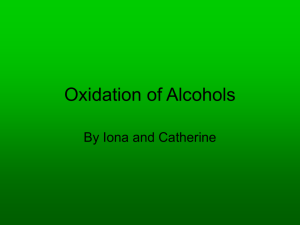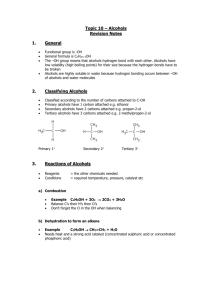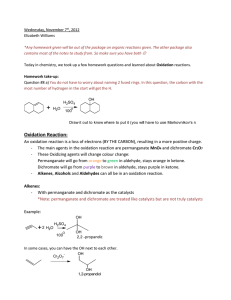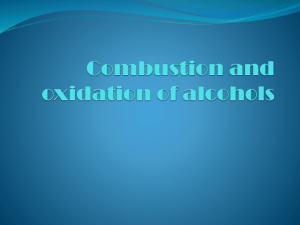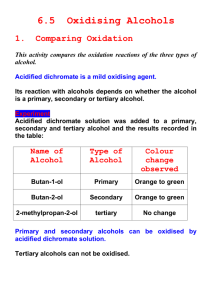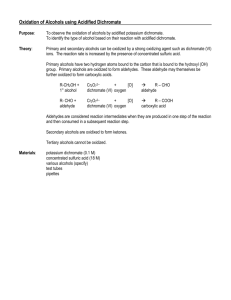Topic 14 – Alcohols
advertisement
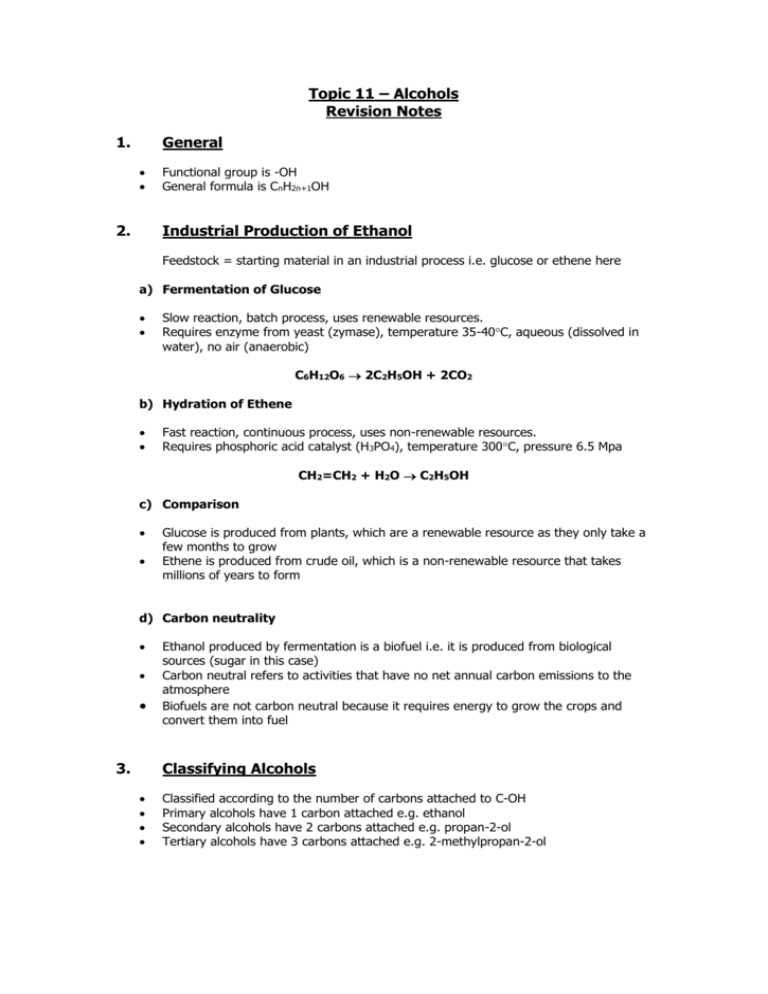
Topic 11 – Alcohols Revision Notes 1. General 2. Functional group is -OH General formula is CnH2n+1OH Industrial Production of Ethanol Feedstock = starting material in an industrial process i.e. glucose or ethene here a) Fermentation of Glucose Slow reaction, batch process, uses renewable resources. Requires enzyme from yeast (zymase), temperature 35-40C, aqueous (dissolved in water), no air (anaerobic) C6H12O6 2C2H5OH + 2CO2 b) Hydration of Ethene Fast reaction, continuous process, uses non-renewable resources. Requires phosphoric acid catalyst (H3PO4), temperature 300C, pressure 6.5 Mpa CH2=CH2 + H2O C2H5OH c) Comparison Glucose is produced from plants, which are a renewable resource as they only take a few months to grow Ethene is produced from crude oil, which is a non-renewable resource that takes millions of years to form d) Carbon neutrality 3. Ethanol produced by fermentation is a biofuel i.e. it is produced from biological sources (sugar in this case) Carbon neutral refers to activities that have no net annual carbon emissions to the atmosphere Biofuels are not carbon neutral because it requires energy to grow the crops and convert them into fuel Classifying Alcohols Classified according to the number of carbons attached to C-OH Primary alcohols have 1 carbon attached e.g. ethanol Secondary alcohols have 2 carbons attached e.g. propan-2-ol Tertiary alcohols have 3 carbons attached e.g. 2-methylpropan-2-ol Primary 1 4. Secondary 2 Tertiary 3 Reactions of Alcohols a) Combustion Example C2H5OH + 3O2 2CO2 + 3H2O Balance C’s then H’s then O’s Don’t forget the O in the OH when balancing b) Oxidation of primary alcohol to aldehyde Here, oxidation means loss of hydrogen Oxidising agent represented by [O] in equations Colour change is from orange to green Aldehyde has functional group -CHO Example CH3CH2OH+ [O] CH3CHO + H2O ethanal Reagents - oxidising agent is acidified potassium dichromate (K 2Cr2O7/H2SO4) Conditions – distil off aldehyde as it is formed Ethanal boils at about room temperature. Ethanol and ethanoic acid have higher boiling points due to hydrogen bonding To stop the aldehyde being further oxidised, it needs to be distilled off as it forms. This removes the aldehyde from the oxidising mixture. This is done by dripping a mixture of ethanol and dichromate into the hot acid c) Oxidation of primary alcohol to carboxylic acid Carboxylic acid has functional group -COOH Example CH3CH2OH+ 2[O] CH3COOH + H2O Ethanoic acid Reagents - oxidising agent is acidified potassium dichromate (K 2Cr2O7/H2SO4) Conditions – reflux (continuously boil and condense) d) Oxidation of secondary alcohols to ketones A secondary alcohol is oxidised to a ketone (functional group –CO-) Example CH3CH(OH)CH3+ [O] CH3COCH3 + H2O Propan-2-ol propanone e) Oxidation of tertiary alcohols Tertiary alcohols are resistant to oxidation as there is no H attached to the C of the C-OH f) Elimination of water to make alkenes Alcohols can be dehydrated using acid catalysts such as H2SO4 and H3PO4 An H is removed from one C and an OH from the next C Example 5. CH3CH(OH)CH3 CH3CH=CH2 + H2O Propan-2-ol propene This method of making alkenes provides a route for producing addition polymers without using monomers derived from crude oil Distinguishing between aldehydes and ketones Aldehydes react with mild oxidising agents such as Tollens’ reagent Ketones do not react with Tollens’ because they are not easily oxidised Tollen’s reagent is ammoniacal silver nitrate. The compound to be tested is warmed with Tollen’s reagent With Tollens’ aldehydes produce a silver mirror whereas there is no reaction with ketones
